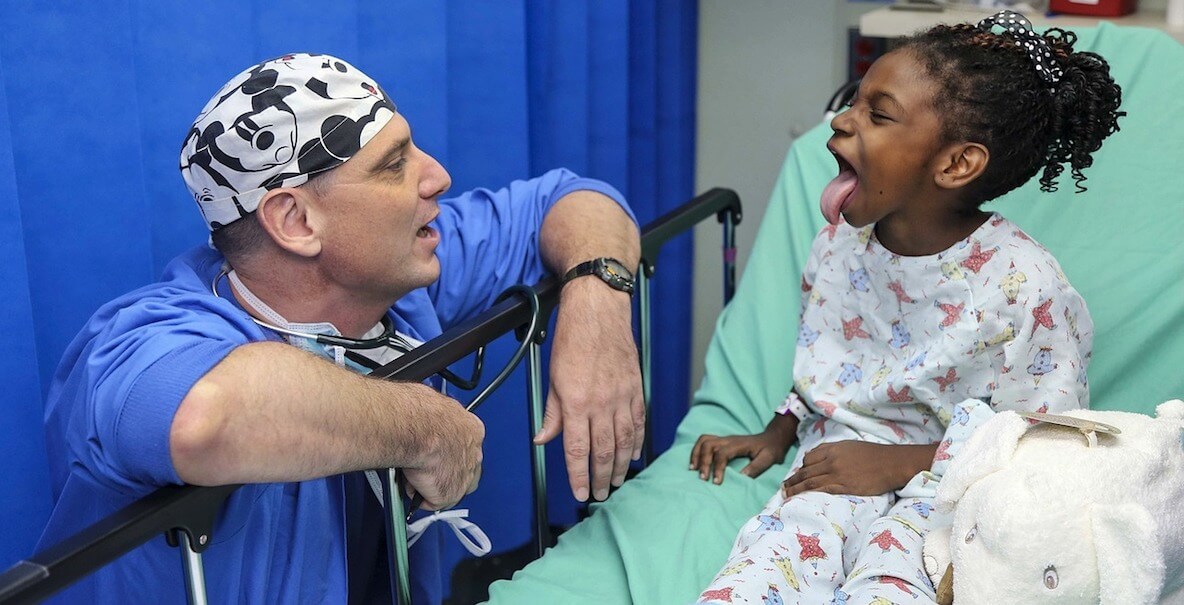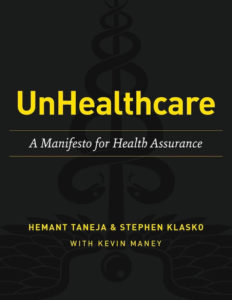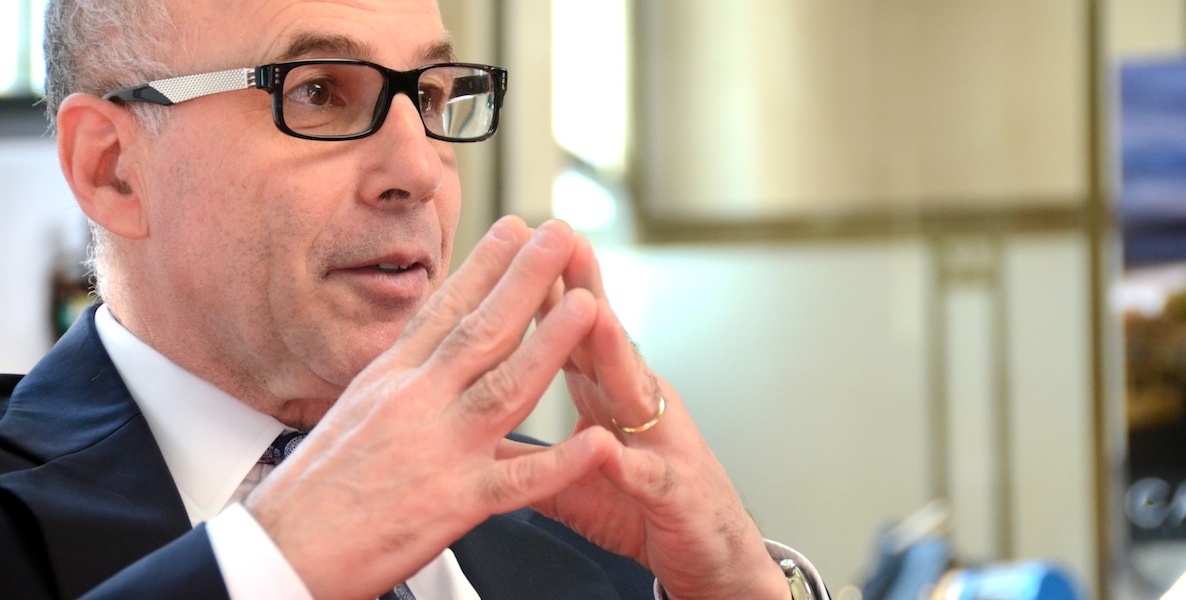Building health assurance is one of the greatest business opportunities in history. How often in any generation does a multi-trillion-dollar global industry go through a reinvention?
For anyone already in healthcare, the coming decade will be something like being in transportation in the mid-Twentieth Century, as trains and horses gave way to cars, and then airplanes. Entrepreneurs and innovators had to invent and make not just cars and airplanes, but a massive infrastructure—airports, airlines, roads, gas stations, radios, motor inns, fast-food joints, suburbs. Nobody could’ve imagined all the possible products and services, and this opened the way for the creation of new giants—General Motors, Boeing, McDonald’s—and new fortunes.
The emergence of health assurance will be just as enormous and thrilling. Everyone in the healthcare industry will have a chance to help recast “sick care” with a consumer-first mindset and make care better for patients than it’s ever been.
Healthcare leaders can embrace this transformation and help drive it—or risk the kind of technology-led disruption that has hollowed out so many other industries. This moment will be to traditional healthcare what the rise of Amazon was to traditional retailers like Sears. Either get on board, or watch yourself become irrelevant.
As we’ve discussed, many healthcare systems have been trying to stay afloat by scaling up and merging in order to cut costs and eke out margins while treating patients the same way they’ve treated patients for decades. But scale is the wrong answer for the 2020s. It will only make the consumer experience more horrible.
Most industries are motivated to please consumers—to give them the best experience at the best price. Otherwise, people will go elsewhere. That market-shaping mechanism has been absent from just about every corner of healthcare.
Here’s a major reason the current system is so bad for consumers, and how it has to change: A health system’s customers aren’t really the people who come in the door needing medical help. Its customers are the payers—the insurance companies. A doctor or hospital can make a patient happy yet the insurance company can refuse to pay for that care. The insurance company wants to pay for as little as possible. The math is pretty simple: an insurer wants to take in more money from employers or individuals than it pays out. (There’s even a term for that: medical loss ratio.) The result is that no one has a financial incentive to do the best thing for the most important consumer: the patient.
So, an old-style healthcare provider wants to do what insurance will pay for, and the insurance company wants to do as little as possible. No one in that model is properly motivated to do what’s best for the person who needs care.
Buy this bookDo Something
In order for consumers to make good decisions about their care, they need clear pricing. That rarely happens in old healthcare. Insurance companies negotiate different prices with every healthcare provider, and don’t want to reveal those prices to the public because payers don’t want one provider to argue that it should get paid as much as another provider. Healthcare systems often inflate claims, knowing payers will deny some and pay a fraction of others. The result: consumers don’t know what almost anything in healthcare is going to cost.
Meanwhile, regulations protect hospital finances, allowing them to keep prices artificially high. A hospital can make ten or twenty times more if a patient comes into the emergency room for a minor problem instead of going online and talking to a telehealth doctor, even though most consumers would be better off starting with an online visit.
Many books have been written about how convoluted the U.S. healthcare system is, and how it shields itself from informed consumer choices. Most industries are motivated to please consumers—to give them the best experience at the best price. Otherwise, people will go elsewhere. That market-shaping mechanism has been absent from just about every corner of healthcare.
Instead, all the frustrated industry constituents—providers, employers, insurers, governments, patients—are trying to force change, first by blaming every other constituent in the complex healthcare ecosystem, and then by trying to shift costs onto those other constituents. This “who’s gonna take the blame” mentality of the current healthcare system will only get worse in the aftermath of Covid, with more uninsured and under-employed people in this country than any time since the Great Depression. At the same time, insurers, providers and payers will try to make up for lost income and the easy path will be doubling down on the sick-care system. Hopefully, consumers, business leaders and policymakers will not take it anymore and accelerate the drive toward this new system.
All of these misaligned incentives have helped create the opportunity to reinvent healthcare into health assurance. In late 2019, we would’ve said that because the system is so large, complex and regulated, change won’t happen in a flash—that it won’t get “disrupted” the way Uber upended taxis in a few years. But after Covid, we’re not so sure. All bets are off.
So if you’re a leader or professional in healthcare today, you can continue to struggle with internecine warfare, bad political solutions and a slow-motion collapse as costs drive away customers. Or you can grab this opportunity and contribute to the emergence of a consumer-centric health assurance industry that will be a vast improvement.
For years, smart people in healthcare have known the industry should put patients in the center. While it seems like a radical idea, it just means that the healthcare industry needs to operate more like nearly every other consumer-facing industry.
This “who’s gonna take the blame” mentality of the current healthcare system will only get worse in the aftermath of Covid, with more uninsured and under-employed people in this country than any time since the Great Depression.
A handful of health systems had been trying—and showing it’s possible for incumbents to find new ways of doing business. Kaiser Permanente is both an insurance company and a healthcare provider for its plan members, so that helps eliminate some of the perverse economics and creates more incentive for Kaiser to do what’s cost-effective for consumers. For its 4.4 million plan members in northern California, Kaiser started offering options to connect with their doctors via phone, email or video. Eighty-seven percent of members said video visits were more convenient than showing up in person, and 84 percent said a digital office visit improved their relationship with their physician.
At Intermountain Healthcare, a Salt Lake City-based system of 24 hospitals and 160 clinics, CEO Marc Harrison has been trying to drive a shift to digital, consumer-first healthcare, even though it sometimes has meant cannibalizing revenue and changing the way people get care. “You’ll get a lot of crap as you disrupt—angry calls from doctors, the community, the state legislature,” Harrison said, before Covid. “You have to be willing to suffer to make this kind of change.”
Here's an easy way to help relieve medical debt locallyDO MORE
At Jefferson, we have a similar offering called JeffConnect for our employees, instituted well before Covid. We’re both the payer (as a self-insured employer) and the provider (as a healthcare system) for that population, which helps align us better with consumers (i.e., our employees). If our employees check out a medical problem by telehealth using JeffConnect, we waive the deductible, even if we direct them to one of our emergency rooms. If they show up at the ER without going through virtual triage, there is a starting deductible of $500. That one change has made for happier patients (they get care closer to home through tele-health, urgent care or a doctor’s office), and has reduced Jefferson’s unscheduled care costs by 25 percent. So, when our people use JeffConnect, they save time and money and we, the employer, save time and money. Everyone is happier.
Such examples are rare in traditional healthcare. The industry needs some leaders who will break the mold, embrace new ways of serving consumers, and help us stay healthy and out of doctor’s offices and hospitals. What most consumers really want is as little healthcare as possible.
Some new companies are showing how consumer-centric health assurance can work. Established healthcare systems would do well to partner with such startups, invest in them, or at least learn from them.
One company offering consumer-centric health assurance is Ro, the company behind sites such as Roman and Rory. Ro offers an easy experience for people who want to treat conditions like erectile dysfunction and insomnia. You can see prices and products; communicate with a doctor online; get a prescription; order the drugs; and have them delivered to your door in slick packaging that would make Apple proud. The cost and time commitment for consumers is a fraction of going to a doctor’s office (and sitting for lord-knows-how-long in a waiting room), taking a prescription to a pharmacy (and waiting in line), and only finding out how much the drugs will cost once the pharmacist rings up the order. This kind of service is getting a ton of press coverage and traction with consumers. Investors (including Hemant’s firm) pumped nearly $100 million in funding into Ro by mid-2019.
Ro can operate in a consumer-friendly way because it goes around the traditional healthcare system. It doesn’t take insurance or prescriptions from your doctor, yet is making these medications more affordable for most people. It’s showing that if consumers find a cheap, easy and transparent way to treat a problem, many will choose that route even if they have health insurance. The gap between a good consumer experience and the usual experience in healthcare is that great.
Livongo is showing what the consumer-centric health assurance approach can do for people with chronic conditions. In a typical healthcare setting, if you’re diagnosed with a chronic condition, you’re pretty much left to manage it on your own. You have to find a doctor, make appointments, get the right medications and take them, learn ways to live that lower the impact of the condition, and on and on. There is no hub, no quarterback, to help you.
The idea behind Livongo is that technology in conjunction with healthcare professionals can act as that hub, that quarterback. It puts the patient at the center, and organizes the care around his or her unique condition and circumstances. The service can guide the patient’s lifestyle choices and track use of medications. It can tell the patient when to see a doctor and when to do something simple to feel better. These kinds of services allow the patient to think less and do less about his or her chronic condition.
If you’re a leader or professional in healthcare today, you can continue to struggle with internecine warfare, bad political solutions and a slow-motion collapse as costs drive away customers. Or you can grab this opportunity and contribute to the emergence of a consumer-centric health assurance industry that will be a vast improvement.
For consumers who are generally healthy, healthcare systems have an opportunity to build what we call virtual primary care. To see how this might work, look at companies like Forward, which pitches itself as membership-based, data-driven “continuous primary care.” In New York City, for instance, you pay $149 a month for a kind of always-on family doctor. There are doctors in an office, and you can see one as often as you want. When you sign up, you get a genetic test and blood test to start building data about your body and health. There’s a Forward app that helps monitor sleep, exercise and other vital signs, and adds the data to your record. In March 2020, Forward added a Covid risk assessment to its app, helping its users navigate the pandemic and know when to see a doctor. A chat bot is available any time, so if you wake up at 2 a.m. with a fever, you can start a chat, and if the software realizes you might have a dangerous flu or, say, appendicitis, it will get a live medical professional to intervene, or send you to a hospital.
Like Ro and Livongo, Forward works outside the old system. It doesn’t take insurance, but is counting on winning over consumers by offering a great experience at a good value. When you factor in copays and deductibles, using direct primary care could save money for a lot of consumers.
Healthcare Disparity in the Age of CovidWatch
Why wouldn’t a healthcare system build something like this? Or why not partner with a company like Forward to give consumers virtualized, always-on primary care that then connects to the system’s hospitals and specialists for emergencies and acute medical problems?
Forward is trying to create a complete healthcare experience. By charging a flat fee, it is banking on keeping people healthier so they don’t have to visit high-cost, human doctors. The software and services and coaching are relatively cheap to offer at scale. Plus, if fewer of its members need to see doctors, those doctors will have more time for people who do come in. The company doesn’t make money on sick care—it makes money on keeping its members as healthy as possible.
We see offerings like Ro, Livongo and Forward as just the beginning, and believe there are even greater opportunities for health professionals who put consumers first.
For instance, the industry has rarely even considered consumer segmentation, the way many brands do. Think of how different segments of consumers might be attracted to services geared for them. Imagine a version of Forward for people over 70, aimed at helping people stay healthy as they age. Or a version for pregnant women, with an OB/GYN doctor at the center instead of a family practitioner. Or a version for young athletes whose goal is to stay as physically fit as possible. And in each of those categories, there’s an opening to offer different levels of care, from basic to super-premium. Perhaps you’d pay more for “all-you-can-eat” access and less for restricted access. Almost every kind of health assurance service could be tweaked for specific consumer segments. As care becomes more virtualized, companies will be able to profitably cater to ever narrower segments.
This is the core of unscaling – taking apart the scaled-up, mass-market operations of last century and replacing them with highly-focused, profitable niche offerings that better serve consumers in that segment. If a consumer can get a customized health experience through the cloud that feels like it was made just for him or her, why would that person ever walk into a mass-market, factory-like general hospital?
Excerpt from Unhealthcare: A Manifesto for Health Assurance by Hemant Taneja and Stephen Klasko with Kevin Maney. Published by Thomas Jefferson Press, Copyright © 2020.







